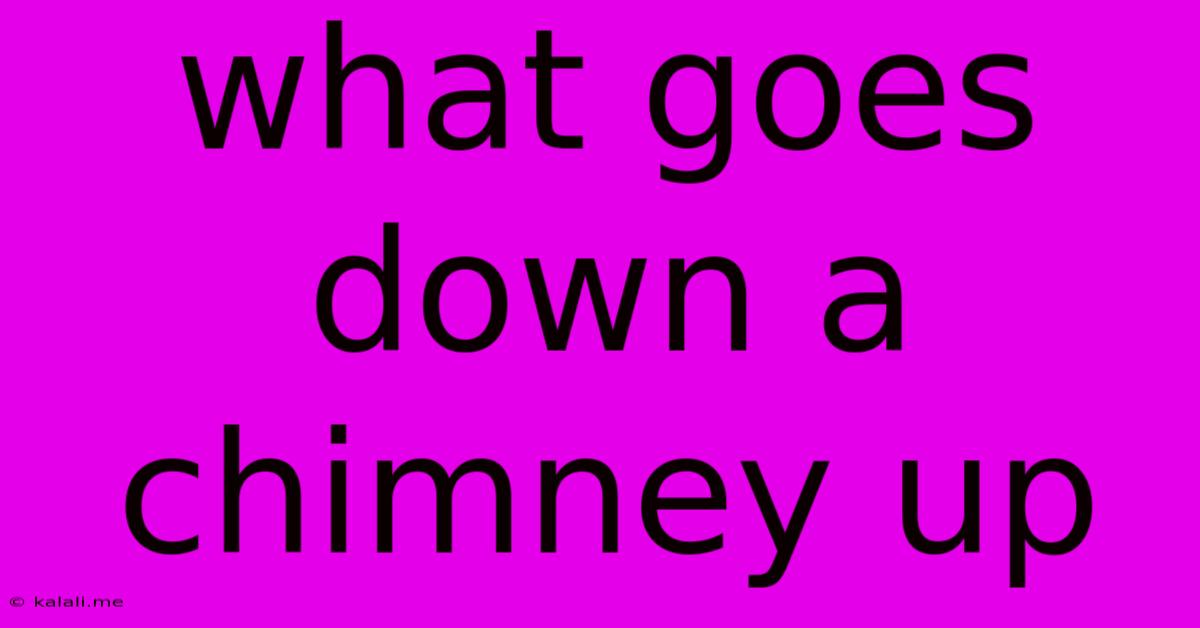What Goes Down A Chimney Up
Kalali
May 21, 2025 · 2 min read

Table of Contents
What Goes Down a Chimney Up? A Surprisingly Complex Question
This seemingly simple question – "What goes down a chimney up?" – hides a surprising amount of complexity. It's a riddle that plays on our understanding of gravity and the function of chimneys, prompting us to think creatively about the physics involved. While the immediate answer might seem obvious, a deeper dive reveals fascinating insights into chimney design, airflow dynamics, and even historical practices.
The most straightforward answer, of course, is smoke. Chimneys are designed to carry the smoke and combustion byproducts from a fireplace or furnace upwards, out of a building, and into the atmosphere. This upward movement is driven by the difference in air pressure – hot, less dense air rises, creating a draft that pulls smoke along with it. This basic principle is crucial for effective ventilation and preventing dangerous buildup of carbon monoxide.
However, the question's ambiguity allows for a more expansive interpretation. Let's delve into some of the less obvious things that might, metaphorically or literally, go "down" a chimney:
Beyond Smoke: Other Chimney Inhabitants
While smoke is the intended occupant, several other things might find their way into a chimney:
- Creosote: This flammable byproduct of wood combustion accumulates within the chimney flue, posing a significant fire hazard. Regular cleaning is crucial to prevent creosote buildup.
- Birds and Nests: Chimneys can provide nesting sites for birds, especially during breeding season. While charming to imagine, these nests can obstruct airflow and increase fire risk.
- Small Animals: Squirrels, raccoons, and other small animals might use chimneys as temporary shelters or access points to attics.
- Debris: Leaves, twigs, and other debris can fall into the chimney, especially if the cap is damaged or missing.
The Physics of Up and Down: Chimney Draft and Airflow
Understanding "what goes down a chimney up" necessitates understanding chimney design and airflow dynamics. The upward movement of smoke is governed by:
- Thermal Draft: Hot air inside the chimney is lighter than the surrounding air, creating buoyancy that drives the upward flow.
- Wind Pressure: External wind can influence the draft, sometimes even reversing it temporarily, leading to smoke backflow. Proper chimney design and height mitigate this risk.
- Stack Effect: This phenomenon, caused by temperature differences between inside and outside the building, contributes to the upward airflow. Tall chimneys are more effective because of increased stack effect.
Historical and Cultural Considerations:
Chimneys haven't always been what we see today. Their design has evolved over centuries, reflecting changes in building materials, fuel sources, and understanding of ventilation. The question "What goes down a chimney up?" could prompt us to consider the history of chimneys and their role in domestic life.
In conclusion, while the simple answer is smoke, the question "What goes down a chimney up?" offers a rich opportunity to explore the science, practical considerations, and even the history related to chimneys and their function. It encourages us to think critically and beyond the immediately obvious.
Latest Posts
Latest Posts
-
How Long Can A Fish Live Without A Filter
May 21, 2025
-
How To Get Dog Hair Out Of The Washing Machine
May 21, 2025
-
Why Australia Is Not An Island
May 21, 2025
-
What Episode Does Luffy Meet Sabo
May 21, 2025
-
0 Is A Multiple Of Every Number
May 21, 2025
Related Post
Thank you for visiting our website which covers about What Goes Down A Chimney Up . We hope the information provided has been useful to you. Feel free to contact us if you have any questions or need further assistance. See you next time and don't miss to bookmark.